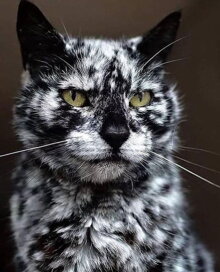Vitiligo in dogs and cats
If your pet's fur has suddenly started to appear white spots, it is very likely that it has a disease known as Vitiligo. This applies especially to dogs and cats.
What is vitiligo?

It is an autoimmune disease that attacks cells (melanocytes) in the body that produce the pigment melanin. Simply put, our skin and animal fur stop producing color. It is not proven what exactly causes this condition, but genetics are believed to play a large role. It has been observed that vitiligo mainly spreads from generation to generation within the family tree. Therefore, if you are thinking about bringing such joy into your life as a dog, it is recommended to ask the breeder if there was a dog with vitiligo in the family tree.
Is there a difference between vitiligo in animals and in humans?
Just like in humans, also in dogs and cats suffering from this disease, vitiligo is mainly associated with stress, occasionally also with diabetes or hypothyroidism. Another possible explanation is exposure to toxins, as a result of which the melanocytes are inhibited and cause the production of the pigment that colors the skin, fur and eyes to stop. The causes can be of various origins. It is not painful, the animal does not suffer and it is not contagious. Nevertheless, it is recommended to see a veterinarian to rule out other diseases with similar symptoms, or potentially associated diseases, since immune diseases often occur simultaneously.

How does vitiligo manifest itself in dogs and cats?
As far as this disease is concerned, the only symptom it manifests itself in is the loss of pigment. There are two types: segmental vitiligo, which affects only one part of the body, especially around the nose and eyes, and then generalized vitiligo, which occurs on different parts of the body symmetrically or even randomly. In some cases, vitiligo, which appears in one place, can spread to the whole body, causing a majority or complete loss of pigment. You can observe the first white spots during the animal's early adulthood, so rather in the 12th-24th. months of life.
How rare is vitiligo for dogs and cats?
Vitiligo is even rarer in animals than in humans. The incidence of vitiligo in humans is very low, affecting only 0.5-2.0% of the global population. There are no data that could determine the incidence of this disease in dogs or cats. But scientists Scott and Miller at Cornell University also addressed this topic, who clarified that 0.7% of horses studied in a veterinary educational institution have an unspecified skin disease. It follows that the occurrence of vitiligo has an even lower prevalence, since it is only one of many skin diseases. Another factor that may contribute to such a low prevalence is that vitiligo is, after all, mainly a cosmetic defect of our pets. Dogs or cats do not have any other symptoms, no vomiting, no diarrhea, or lethargy, and therefore the owners do not have such a great urge to run to the vet with them. That is why not many cases are recorded and the numbers are inaccurate.
Does vitiligo affect other animals besides dogs and cats?
The most common breeds of dogs with vitiligo are German Shepherds, Rottweilers, Dachshunds, Golden Retrievers, Huskies, and Labradors. In addition, it also affects horses, some birds, and cattle. These are just a few known cases, there are certainly other species of animals that have vitiligo but are not recorded.

Can vitiligo be dangerous and is treatment necessary?
In most cases, vitiligo treatment is not necessary, because it is not dangerous for animals. Some veterinarians recommend exposing the animal to more sunlight. Some recommend being more careful about the animal's diet and including vitamin C and omega-3 in the diet, either in the form of supplements or foods that contain it. It will not bring back the lost color, but it can slow down or even stop the process of spreading white spots and your pet will have a healthier life and coat.
What is usually recommended to owners of affected animals is to observe whether the animal is under stress. It is important to find the source of stress and reduce it as much as possible, change the environment and thus prevent the formation of more white spots. A veterinarian may still suspect another immune disease because vitiligo often occurs hand in hand with another disease and take appropriate steps to prevent the development of the disease.
It is important to remember that at the first symptoms you should see a doctor to rule out possible associated problems. And most often, thanks to this disease, your unique pet only becomes even more unique with its coloring.
Summary of tips to slow the spread of vitiligo:
Include vitamin C and omega3 in the diet.
Exposure to sunlight as often as possible.
.jpg)